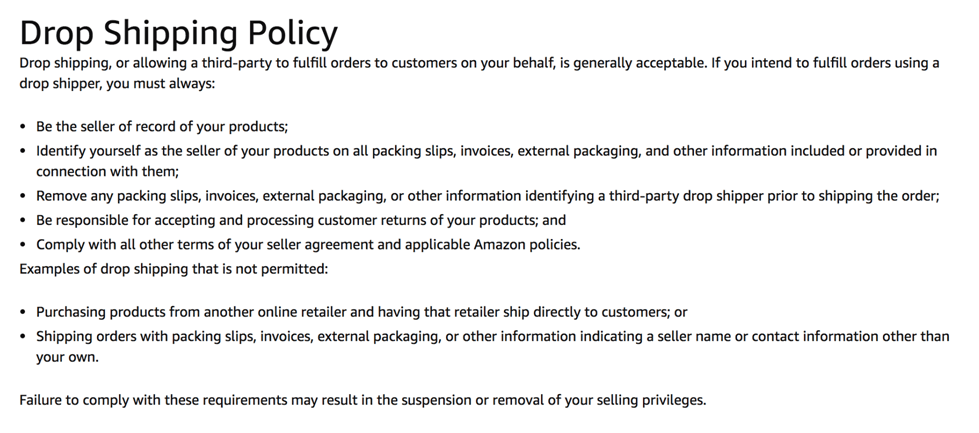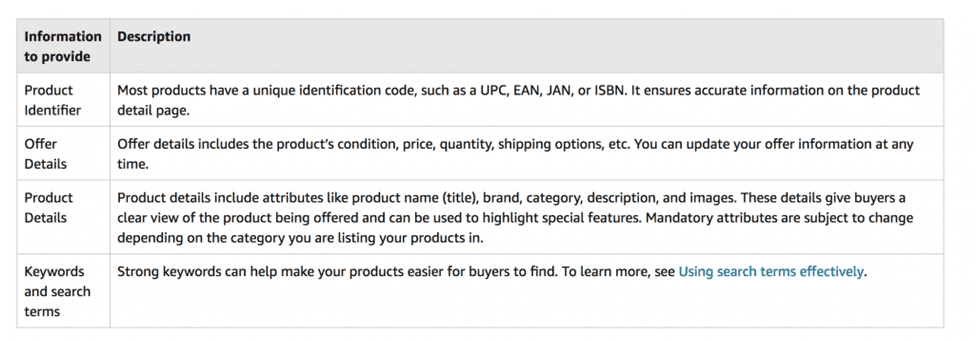
If you’re looking to start an ecommerce business but don’t have the space to store inventory, you have probably heard that dropshipping on Amazon is the way to go.
With this business model, sellers don’t need to worry about buying or storing inventory, renting a warehouse, or shipping out items.
So who bears the responsibility of product fulfillment? Suppliers do.
Dropshipping suppliers bear the costs for packaging, inventory, and shipments, in addition to facilitating product handling and storage. This helps eliminate the time and costs associated with conventional distribution channels.
Now, if we add Amazon—the world’s largest ecommerce company—into the equation, things get quite interesting.
With the company’s website attracting over 2 million visitors each month, Amazon provides you with a large audience to sell to. Also, the retailer is fine with sellers using its technology and marketplace to sell products and having the fulfillment handled by a third party. Simply put, it’s possible for sellers to make money online via Amazon dropshipping.
In this blog post, we are going to explore exactly how Amazon dropshipping works, the important advantages and disadvantages to consider, and what is required of you to dropship on the platform.
How Does Dropshipping on Amazon Work?
Amazon dropshipping works in the following manner:
- You sign up as a seller with Amazon.
- You list your products on their website without holding any stock.
- When someone places an order, you simply inform your dropshipping partner, and they take care of the fulfillment.
It’s that simple. However, Amazon has certain guidelines that dropshipping entrepreneurs should follow. Here’s a visual excerpt of their dropshipping policy section.

Amazon may ban you from selling through its website if you fail to comply with these rules.
With so many policies in place, why would someone want to dropship on Amazon? Simply put, Amazon is a powerhouse, and there’s no better way to get eyeballs on your product than to sell through Amazon.
However, there are some important legal considerations you need to be mindful of. For example, you need to ensure that you comply with the tax laws of your country. If you’re from the US, for instance, you’ll need to submit a tax ID in order to sell on the website.
Similarly, you have to comply with privacy laws of a country. Europe-based sellers who collect various types of visitor information are required to inform visitors that they are doing so according to the EU Cookie Law.
Amazon will also investigate if the items you list are infringing on any copyrights. Unauthorized use of trademarks, taglines, images, and even colors can get you banned for life.
Advantages of Amazon Dropshipping
Besides giving you access to a big audience, Amazon dropshipping offers the following benefits:
1. Low startup cost
Because you’re not paying for any shipping or warehousing, the money you need to get started is close to zero. All you have to invest in is an Amazon seller account which costs $39.99 a month. This is nothing compared to a conventional ecommerce business where you need to buy the items in advance.
2. Ease of Entry in Various Niches
This is one of the biggest advantages of Amazon dropshipping. With a good supplier and the right product, there is no limit to how many niches and categories you can cover. For example, you can sell in the Arts & Crafts and Tech Accessories categories simultaneously as there’s nothing to prevent you from entering new markets.
3. Professional Store
Starting a store on Amazon requires little effort on your part. Compared to creating an ecommerce website where you have to manage the hosting, domain registration, and website design, all you need to do is to create an Amazon seller account, and you’re all set. Moreover, you don’t need to pay for hosting your product texts and images as everything is hosted on the company’s high-end servers.
Disadvantages of Amazon Dropshipping
Just like any other business avenues, Amazon dropshipping also has a few disadvantages:
1. Competition
Undoubtedly, there is a lot of competition on Amazon. You won’t be able to take the sole benefit of dropshipping because several other entrepreneurs are dropshipping the same items as you. The good news is that there are ways to stand out from the competition. For example, you can try winning the Amazon Buy Box or do some SEO to attract more visitors. We’ll discuss these methods in detail in the next section of the article.
2. Lack of control over packaging
Amazon dropshipping also eliminates the opportunity to customize product packaging. Because the products go out directly from the supplier’s warehouse to the customer, the seller doesn’t get a chance to place specialized promotions or materials inside the box. This drawback can hinder your offline branding efforts.
3. No guarantees
Just like any other business, Amazon dropshipping doesn’t guarantee that you’ll end up making a profit. In fact, you need to be strategic while creating the product mix that you want to list because it’s unlikely that every item out there will provide you with high margins.
How to Get Started with Amazon Dropshipping
To dropship your first batch of items on the website, you’ll need to take the following steps:
1) Find a supplier
The first and foremost requirement of Amazon dropshipping is to find a trustworthy supplier. Because wholesalers are likely to offer the best purchase price, we recommend researching wholesale directories or attending tradeshows.
The other option is to search “gold” suppliers on Alibaba. Gold suppliers are premium product vendors who have a good reputation and a track record of strong sales. With that said, they might take a few weeks to get the products to your customer, so make sure to choose someone who offers low shipping times.
Because Amazon’s policy says that you aren’t supposed to buy products from another retailer and have that retailer ship them directly to the customer, you must build a relationship with any supplier you work with.
Ask them to use a third-party fulfillment center for shipping. In addition, make sure to request that suppliers not include any invoices, packing slips, and other documents that have their name on it.
2) Choose a fulfillment center
The second important step is to find a third-party fulfillment center that will ship your products on your behalf once they arrive from your supplier. A pro tip is to look for fulfillment centers that are near the place you’re aiming to sell in.
For example, if you’re looking to sell on Amazon.com, it’d be best to find a fulfillment center in the U.S. because the website is geared towards attracting audiences from this country.
Alternatively, you can sign up for Amazon FBA for a fee. This is Amazon’s native fulfillment service that takes care of all the logistics on behalf of the merchant. With this option, you can ask your suppliers to ship products with your name and branding on top to Amazon’s fulfillment center, and the ecommerce company will take care of the rest.
3) Create a seller account
Amazon only allows merchants with a seller account to dropship on its platform. The seller account comes with a price tag and is categorized into two plans. The first plan takes a $0.99 fee on each sale made regardless of the volume. The second plan eliminates the charge but requires you to pay $39.99 each month.

4) Choose an eligible category
Amazon puts some limits on selling in certain categories. They have a compilation of “open categories” – the items that fall in these categories can be listed without approval. However, others require you to seek permission from Amazon.
5) Create a product listing
The last step in the process is to create a listing for your products. For items that already exist in the company’s catalog, you can develop a listing by opening the webpage of the product and selecting “Sell on Amazon.”
For products that aren’t listed on the website, go to your Amazon seller account and use the “Add a Product” option to make a new listing. Also, make sure to keep the following details by your side:

With that, you’re ready to dropship on Amazon.
Bonus Tips for Amazon Dropshipping Success
Now that you know how to manage the logistics and sell products on Amazon, let’s go over a few techniques that you can use to attract potential customers. Here are some tried and tested measures to consider:
1) Optimize Your Product Listings for SEO
Like WordPress and Shopify, Amazon allows you to optimize your storefront for search engines. The first thing to optimize? Your product title. Make sure to create a descriptive product title and include information such as color, model number, dimensions, brand name, etc. Also, include relevant keywords in the content field of your listings to make them discoverable for search engines. Done correctly, SEO can bring tons of visitors to your Amazon store.
2) Go for the Buy Box
For those unfamiliar, the buy box is the top right section on an Amazon product listing page that allows people to add products to their shopping carts. About 90 percent of the time, the merchant featured in the buy box makes the sale. Therefore, winning the Amazon buy box can work wonders for your dropshipping business. To qualify, you should aim to achieve a seller rating of 95 percent or above. Another thing you’ll need to be able to offer is a shipping time of 14 days or less. Lastly, pricing your products lower than other sellers on Amazon may also help you win the buy box. You can get the help of an Amazon consultant company like Buy Box Experts to help you succeed in winning the buy box.
3) Get customers to leave reviews
Amazon product reviews are known to increase the credibility of merchants and the appeal of the items they sell. The good news is that it’s simple to get customers to leave reviews. All you need to do is email the consumers who’ve purchased your items. Show some gratitude and then ask them to leave a review if they’re satisfied with their experience. You can also include the URL of your product listing page in the email to make it convenient for them. And if someone leaves a negative review, try to explore the root cause of the issue, apologize, and offer an alternative if you need to.
Conclusion
There you have it, a detailed guide on how to dropship on the world’s most popular ecommerce website. We hope the tips we shared in this article help you gain a better understanding of how to find a supplier, create a seller account, optimize a product listing and start making money via Amazon dropshipping. Getting the basics right and having as many recommendations at your fingertips as possible can mean the different between dropshipping failure and success. So if you want to set up a lucrative business in a short period, dropshipping might be the way to go.

If you’re one of the estimated 20%–40% of brands who fire their agency annually, you can’t focus on that vision if you have to keep searching for the right support. BBE proudly retained >95% of our clients last year while applying focused dedication to our brand partners. If you’re ready to start over for the last time, contact us and find out why leading brands have partnered with us for so long.

